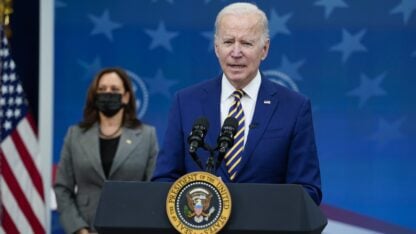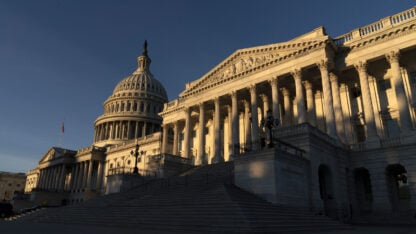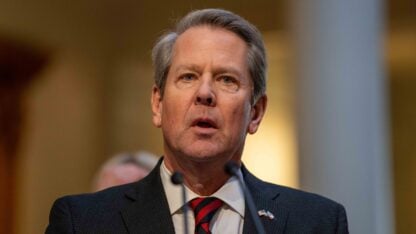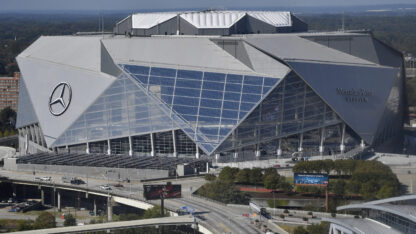WABE sent questions about environmental issues to all of the mayoral candidates. The questions cover climate change and extreme heat, water resources, park maintenance, the tree ordinance and lead contamination in West Atlanta neighborhoods.
The questions are in bold, and Mark Hammad‘s answers follow. Answers were edited for clarity.
Read answers from other candidates.
The U.S. Environmental Protection Agency recently expanded the area in English Avenue and Vine City where properties may need to have their soil completely removed and replaced, after finding dangerous levels of lead in people’s yards.
What role do you think the City of Atlanta should have in engaging with the community, and what is your plan to address this potential children’s health issue in West Atlanta neighborhoods?
The mayor’s role in this issue should be outreach, education and pushing for expanded testing. We need to engage these communities and provide information regarding the dangers of lead, especially in childhood development. We need to provide the resources to allow residents to contact the city if they feel that their property or their children are at risk.
Secondly, while testing is already taking place, we need to advocate for more expanded testing to ensure that the limits of contamination have been properly identified. We need to engage with the EPA, our federal partners, and the community to identify what the remediation plan will look like and what impact this may have on residents in the area.
Lastly, we need to engage the community and liaise with health organizations to perform frequent health screenings for lead in children who are in the impacted areas. While the EPA will test, monitor and remediate the soil, the real risk is lead ingestion by children — this is really what we need to be monitoring.
While Atlanta has some big, beautiful new parks opening now and coming soon, many city parks need maintenance. According to the Park Department’s long-term planning program, Atlantans said the number one thing discouraging them from using their parks was that they were not well maintained.
How would you ensure that parks — whether they’re new or old, big or small, regardless of the neighborhood — get adequate funding and maintenance? And how would you involve communities in decisions about their parks?
Basic city services, which includes parks, are a top priority of mine. Right now, the city is not doing their job with respect to basic maintenance and cleaning of the parks. The city has shirked much of their responsibility and is instead relying on the goodwill of private and non-profit organizations to do much of the heavy lifting when it comes to park maintenance and cleaning.
First, on the existing parks we do have, we need to ensure that they are safe, and people feel safe going to the park. Secondly, we need to ensure that they are clean, well maintained and have amenities that are desirable. These are the responsibility and obligation of the city, not private organizations. I will ensure that the budget is sufficient to take care of all the maintenance needs for all of our parks.
I will involve the communities in decisions regarding their local and accessible parks. We need to provide desirable amenities at all of our parks that will make them more usable. In order to do this, we need to engage with each local neighborhood to get their input on what they want, be it green space, walking trails, playgrounds, etc.
Atlanta is losing its tree canopy, and the city has taken years to finish a promised re-write of the tree protection ordinance.
How would you make sure the ordinance update is completed, and ensure that it is enforced?
Right now, the current ordinance has some shortcomings. Some developers see it as a means and a “pass” to take down trees and just pay a fine. This was certainly not the intent of the ordinance.
We need to focus on two solutions. First, we need to make sure that the city has an appropriate level of staffing to manage and enforce the current ordinance. Many developers and residents complain of waiting weeks or months when contacting the city. Second, we need to bring developers to the table to identify solutions that are acceptable to the city, the community and the developers. While this may not be palatable to the most ardent advocates for our trees, the current system is not working and we need to involve all parties.
Atlanta is hot and getting hotter. Often the hottest neighborhoods are in vulnerable communities of color. Atlanta also has many households with high energy burdens that pay a high proportion of their income to energy bills. Not everyone can afford to run the air conditioner all summer or afford efficiency upgrades to keep their homes cooler — and heat can be dangerous.
What role do you see for the mayor’s office in addressing the health risks of extreme heat?
There are already a number of programs available to assist low-income and fixed-income households with utility bills. We can engage in more outreach and education in order connect at-risk households with the organizations and programs designed to assist.
Secondly, the city needs to have a proactive plan to deal with extreme heat days that may (and likely will) occur in the future. This includes:
- Opening of community centers for cooling those at risk
- Providing transportation to cooling centers
- Welfare checks on at-risk residents
Lastly, over the long term, we need to prioritize green development and the incorporation of green spaces to reduce the heat island effect, especially in higher-risk areas of the city.
To address climate change, the City of Atlanta prepared a climate action plan in 2015 on how to cut emissions. The city also made a commitment to achieve 100% clean energy by 2035. But progress towards that goal has been slow.
What, if anything, would you do to keep Atlanta moving towards emissions reductions? And how would you prepare Atlanta communities to weather the effects of climate change, which include extreme heat, increased flooding, mosquito-borne disease and worsening air quality?
The biggest climate and transportation issue that Atlanta faces is being extremely car-dependent. We need a leader who will support and advocate for real public transit expansion, giving residents and commuters viable options and moving away from our car dependency.
Transportation is my wheelhouse and an area I know very well. I have worked as a transportation consultant and I have experience working on every type of transportation project, including roads, highways, streetcars (light rail), bus rapid transit (BRT), subway (heavy rail) and aviation.
Through my experience, I have become an ardent public transit advocate and supporter. What Atlanta needs is a leader who will champion a real expansion of the MARTA system. The Atlanta region has not done a major expansion of MARTA in more than 20 years. In that same time, the Atlanta region has grown immensely.
Atlanta lacks real transportation options and alternatives for commuters and we all suffer as a result. We see this in the traffic that chokes the connector, I-85, SR400, I-75, I-20 and I-285 on a daily basis. As mayor, I will advance an expansion of MARTA up to Gwinnett, North Fulton and Cobb counties. We need a leader who will bring together all the stakeholders to get a real regional expansion completed for MARTA — this includes dozens of local municipalities, the state of Georgia and our federal partners.
For many in the Atlanta region, having a car is not a luxury, but a necessity and we need to provide alternatives to allow people the choice to move away from being car-dependent. This will allow both the city and the region to be more sustainable as we grow. This will also drive development and continue to attract businesses and residents. Expanding public transit will allow Atlanta and the region to achieve many goals, including sustainability, growth, development, equitable access and equitable opportunities for everyone in the Atlanta region.
Georgia won a major legal victory in the water wars in the U.S. Supreme Court earlier this year, but there is still another case ongoing. And, Florida, Georgia and Alabama have not found a resolution between themselves. Metro Atlanta is subjected to both floods and droughts — both of which climate change will likely worsen — and we must share our limited water supply within the region and with downstream neighbors.
As the mayor of Atlanta, how would you see your role in addressing and preparing for the region’s water challenges?
Our water supply comes from the Chattahoochee, like many communities and cities along the river. There are many stakeholders involved at the local, state and federal level. First, we need to identify what the potential challenges are, primarily related around water quality, water quantity and availability, water usage and water demand.
For each of these, we can help reinforce a framework and monitoring, as well as having a proactive plan in place [if] one of the primary water challenges becomes a viable risk.
The framework and monitoring should include the following elements:
- Monitoring water quality, both upstream and downstream from intakes and water treatment facilities. This should extend beyond the section of the river that the city is adjacent to. We need to be able to have sufficient monitoring to identify water quality issues at any point up or downstream from us.
- Water quantity and availability should be monitored and evaluated to determine if we are approaching any risk thresholds related to long-term supply, or if we may be facing drought conditions.
- Water demand needs to be closely monitored. Should future demand increase without careful consideration of the availability, we could put ourselves onto an unsustainable path for the future.
- Lastly, we need to monitor the level of water usage by type. This includes personal, recreation, industrial, processing, agriculture, etc. We need to ensure that the water resources are not being disproportionately allocated to certain sources, to the detriment of other sources.
Lastly, we need to have a proactive plan in place should drought conditions occur (as they have in the past). This will include where we can cut usage and demand and where we can conserve while still meeting all the basic needs and functions of the residents in the city.
Read answers from other candidates.








